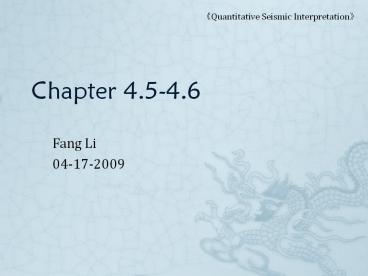Fang Li - PowerPoint PPT Presentation
Title:
Fang Li
Description:
Ray tracing. Gaussian beams method. Finite difference method. Finite element method ... Ray tracing. Ray tracing can be used to compute seismic wave travel ... – PowerPoint PPT presentation
Number of Views:65
Avg rating:3.0/5.0
Title: Fang Li
1
Chapter 4.5-4.6
Quantitative Seismic Interpretation
- Fang Li
- 04-17-2009
2
Outline
- Forward seismic modeling
- Future directions in quantitative seismic
interpretation - References
3
Forward seismic modeling
- What?
- Seismic modeling is essentially the construction
of geologic computer models and simulating their
seismic wave propagation response. - Why ?
- Forward modeling of geophysical data is a tool
used as a survey design aid and to constrain the
interpretation of recorded/processed seismic data.
4
- When?
- Before and after the acquisition of seismic field
data. - Where?
- Laboratory
- Computer
- Solve the equation of motion for seismic waves
- Newtons second law of motion
- Constitutive relation, such as Hookes law
5
- How?
6
Methods
- Convolution model
- Reflectivity method
- Ray tracing
- Gaussian beams method
- Finite difference method
- Finite element method
- Pseudo spectral method
Ray Theory
Wave Theory
7
Convolution model
- 1gt WAVELET NI
- 2gt
- Migrated seismic profile
- 3gt Simplest Useful
- 4gt
- Far more including all
- Multiples, converted
- Waves, and attenuation
- Effects
8
From Neil Anderson (2002)
9
Reflectivity method
- For the creation of the complete elastic
body-wave responses from a horizontally layered
system - Including all possible multiples,mode
conversions ,and transmission losses.
10
With multiples
Without multiples
PP SS
From CREWES Research Report-Vol16(2004)
11
Ray tracing
- Ray tracing can be used to compute seismic wave
travel times and amplitudes along ray paths in a
heterogeneous medium when the frequency present
in the wave are high enough so that the
geometrical optics approximation can be used.
12
From CREWES 2004
Class 2 AVO
Class 1 AVO
13
Finite difference method(FD)
- The finite-difference method is powerful and
flexible in accounting for complex
non-homogeneities and arbitrary anisotropy of a
medium - Produce full wavefield
- Proper for complicated structures
- Involving grid dispersion and edge effects
14
From Yongyi Li (2007)
15
Summary
- All modeling methods are rooted in the same
physical theory. - Each modeling method has specific strengths and
weaknesses. - Any particular method has limited ability to
represent this underlying physical reality.
16
Future directions in quantitative seismic
interpretation
- More rigorous modeling and inversion of the wave
propagation phenomena - Combing sedimentologic and diagenetic modeling
with rock physics modeling to obtain more
realistic predictions of seismic properties
17
- Probabilistic Monte Carlo simulations to capture
uncertainties in both rock physics and inversion
results - Incorporation of geostatistical methods to
account for spatial correlations in reservoir
properties
18
References
- Krebes E.S. , Seismic forward modeling, CSEG
Recorder, 2004. - Margrave G.F, Seismic modeling An essential
interpreters tool, CSEG 2004. - Anderson N., Forward seismic modeling the key to
understanding reflection seismic and ground
penetrating radar(GPR) techniques, 2002. - Chopra S., Seismic elastic modeling, CSEG 2005
- www.crewes.org
19
Thank you !!Have a good day!































